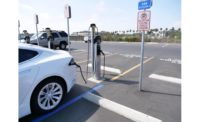10-minutes with Electric Grid Visionary Doug Houseman

Houseman estimate there's at least $4 trillion in grid modernization work to be done in the United States.
Photo courtesy of the Lawrence Livermore National Laboratory.
During the annual DistribuTECH conference in New Orleans in early February—one of the largest electric utility conferences in the world with 12,000 attendees—Doug Houseman, utility modernization lead for Burns and McDonnell, sat down with Engineering News-Record to talk about the massive electric grid modernization efforts that the utility industry must undertake to allow the grid to take full advantage of renewable power, distributed generation and electric vehicles.
How do you define grid modernization?
Houseman: “Making the grid capable of supporting electrification, distributed energy resources, generation, storage and demand response and making it responsive to control signals so that the grid is no longer just a passive piece of the system but it is actively managing and scheduling the resources that can be managed in that portion of the grid.”
How big is the grid modernization market?
Houseman: “I don’t think anybody really knows how big this market is. A few years ago, Bloomberg asked me what it would take to modernize the distribution grid. Going through and using rules of thumb, it was about $4 trillion. That’s more than all of the utilities are valued at in the market today.”
What kind of work will grid modernization mean for engineers and contractors?
“There’s work for everybody. It starts with a strong foundation which we’ve kind of let slip since the 1980s. Replacement rate [should be] about 2.5% of asset value each year and we’ve been running about 1.1% each year for distribution since late 1990s.
“Now we’ve got 20+ years of accumulated deficit in terms of spending. We have 300 million poles in the United States. Rough estimate by DOE, 40% of those poles are overage. That’s a lot of work for the engineers and contractors. About 50% of conductor is over age. We have 5.5 million miles of conductor and half of that is 2.75 million miles – that’s a significant amount of conductor. I don’t care what you do in this industry, if you are going to build that strong foundation, in order to have electrification, in order to be able to support people putting photovoltaic on their roof, we need to be willing to fix the infrastructure or we need to be able to say every house is their own microgrid, pony up your $50k
Why should all of this money be spent on upgrading the grid instead of distributed energy resources?
“You want to go to distributed resources and you want power 24 hours a day? Based on a study done by the National Renewable Energy Laboratory, you need to spend $53,000 if you’re an average us customer to put in the solar and batteries and the inverters and the other things you need at your house. If instead you put in solar and you want the grid to be the battery, you’re talking $14 trillion to upgrade the infrastructure because you have to put in enough storage or we will go dark at night.
Are there any cities or areas with a completely modernized grid?
“There is nobody that has a completely modernized grid. Southern California has a couple of smart circuits, Austin has a smart neighborhood, and those are some of the leading projects. Nobody has taken their whole grid and modernized it at this point, everybody has done a pilot project here and a pilot project there and they realize how complicated it is and how much of the underlying stuff they have to replace to make the project go.
“Everybody has announced grid modernization projects, but they are talking about replacing closers or remote fault indicators. The problem is picking one class of equipment to replace or install doesn’t give you a modernized grid, it gives you some additional capabilities. “
Why hasn’t more been done?
“If the regulators would turn on the money, we could do a significant amount of grid modernization. The unfortunate thing is we have not as an industry made a good case to regulators for why we need to do the kind of work that we need to do.”
How can the electric utilities begin to make their case?
“Build to a new set of standards, and that’s where it’s got to start. Not IEEE standards, but 'this is the way the pole is built, this is the size wire that is put on it and these are the construction drawings used in the field'. The last set of standards was developed in the early 1980s. We had about 500 kW of photovoltaic then. Mostly what people have done is mark up those 40-year old standards with new equipment, but we haven’t fundamentally rethought our construction standards as a nation in 40 years.
“All of our constructions standards are 2D. We need to take a step back and look at 3D. Many utilities are tackling it a chapter at a time but maybe it’s time to get all of the industry utilities together again like they did in the 1980-1983 time and reassess our standards. “




